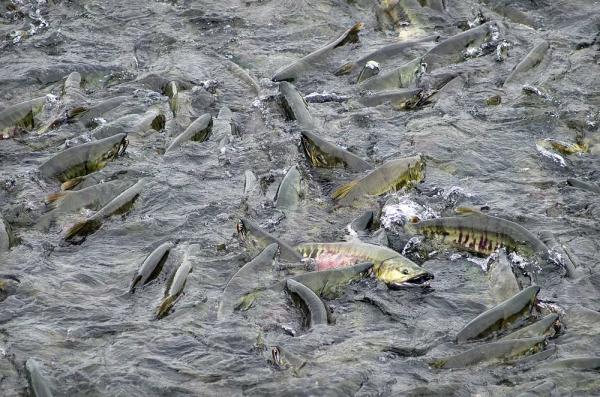It wasn’t on the agenda, but the FDA’s announcement about genetically engineered salmon rapidly became the talk of the Pacific Marine Expo in Seattle.
The expo, held each November, brings thousands of Alaska fishermen and experts together to buy, sell and just talk fish.
Attendees had plenty to talk about after the federal government announced that it had approved the sale and human consumption of a salmon engineered to grow more quickly in fish farms.
Nowhere was the talk more pronounced than at an afternoon meeting of the salmon committee of the Alaska Seafood Marketing Institute.
“Personally, I’m pissed. Super pissed,” said one Southeast Alaska fisherman who asked that his name not be used. “At a time right now when we need help in this industry … it pisses me off.”
Andy Wink, a senior seafood analyst for the Juneau-based McDowell group, said salmon prices have plunged in recent months due to a variety of factors including the strong dollar, big harvests and the Russian embargo on imported food, which has shrunk the global market.
In the short term, the engineered salmon’s approval won’t matter much. In the long term, things are different.
“It’s a huge long-term issue,” he said. “Just because this goes through, it doesn’t mean that next month they’re going to go through the door.”
In 2013, a New York Times poll found three-quarters of Americans had concerns about genetically engineered food, and 93 percent said they supported laws requiring the labeling of such foods.
No such laws have passed Congress, which leaves Alaska salmon fishermen, wholesalers and marketers in a tough spot. When engineered salmon reach store shelves, there may be no way to tell them apart from Alaska salmon.
“That’s really a huge issue,” Wink said. “It could take away from consumer demand for salmon in general, and that would be a bad thing for Alaska.”
Alaska’s delegates to Congress have repeatedly introduced measures mandating labeling, but those have remained stalled or defeated.
Tyson Fick is a spokesman for the state-owned ASMI and spoke at the Seattle meeting on Thursday. By phone, he said the approval of the engineered salmon makes ASMI’s mission more important than ever.
“From our perspective, without labeling, the only way consumers will know the difference … is through groups like us,” he said. “Our job is especially tough and it was just made a whole lot tougher.”
ASMI has tended to promote “positive” marketing campaigns that push the health benefits of wild salmon and their sustainable harvest. It hasn’t often dipped into negative campaigning, and it’s not going to start now, Fick said.
“We haven’t gotten in the business of bashing our competitors in the past, and I don’t think we’ll go that route this time.”
If consumers overcome their fears of engineered salmon, Wink said, the worry is that the fish could fundamentally alter the cost to bring salmon to market. If an engineered salmon is overly cheap for fish farms, it could price Alaska fishermen out of the market.
“The real crux of it is how much it is going to decrease salmon farmers’ operating costs,” Wink said. “There’s a lot of ways that this can go. We’ll have to see.”

